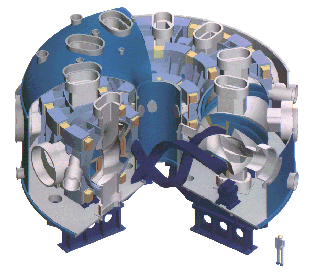| Contents: | Return to Home Page | |
| Fusion Concepts | Controlled Fusion Methods | Modern Research Efforts |
| Conceptual Overview | Inertial Confinement Reactors | Internal Confinement Research |
| Conditions for Fusion | Magnetic Confinement Reactors | Tokamak and Stellerator Research |
 The world's current largest stellerator design was first run in Japan during 1998 and is called the Large Helical Device. Although stellerator designs
are generally not as successful as their tokamak counterparts, the LHC is capable of reaching energies and temperatures similar to those of rival
designs. Also, there is no toroidal field or current present in the LHC. Instead, magnetic fields originate from large superconducting devices
which surround the reactor. Data gained by the LHC has gone to improve other Helical devices and to understand fusion as a whole.
The world's current largest stellerator design was first run in Japan during 1998 and is called the Large Helical Device. Although stellerator designs
are generally not as successful as their tokamak counterparts, the LHC is capable of reaching energies and temperatures similar to those of rival
designs. Also, there is no toroidal field or current present in the LHC. Instead, magnetic fields originate from large superconducting devices
which surround the reactor. Data gained by the LHC has gone to improve other Helical devices and to understand fusion as a whole.